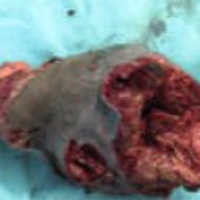Retroperitoneal extension of massive ulcerated testicular seminoma through the inguinal canal: A case report

Accepted: June 26, 2020
All claims expressed in this article are solely those of the authors and do not necessarily represent those of their affiliated organizations, or those of the publisher, the editors and the reviewers. Any product that may be evaluated in this article or claim that may be made by its manufacturer is not guaranteed or endorsed by the publisher.
Authors
Introduction: Testicular cancers represent about 5% of all urological malignancies and 1-1.5% of all male neoplasms. Most of the testicular cancers are localized (68%) at diagnosis. Bulky masses in the scrotum are rare. We present a rare case of bulky testicular cancer with retroperitoneal spread through the inguinal canal.
Case report: A 44-year-old man came to the emergency department referring weakness and the presence of a scrotal mass. At physical examination, a voluminous mass was found, with necrotic phenomena within the scrotum. Abdomen was tense and sore. Abdominal CT scan revealed a bulky testicular mass spreading to the retroperitoneal space through the inguinal canal with node enlargement. Patient underwent orchiectomy with excision of infiltrated scrotum skin. Histologic diagnosis confirmed a typical form seminoma. The patient was then treated with a cisplatin-based chemotherapy, with a partial response. The patient recently relapsed and he is being treated with a new line of chemotherapy and subsequent surgery with or without radiotherapy.
Conclusions: We described a rare presentation of testicular cancer. This case highlights the importance of a multidisciplinary approach to rare testis tumour presentation and early diagnosis for testicular cancers.
How to Cite
PAGEPress has chosen to apply the Creative Commons Attribution NonCommercial 4.0 International License (CC BY-NC 4.0) to all manuscripts to be published.

 https://doi.org/10.4081/aiua.2021.1.64
https://doi.org/10.4081/aiua.2021.1.64



